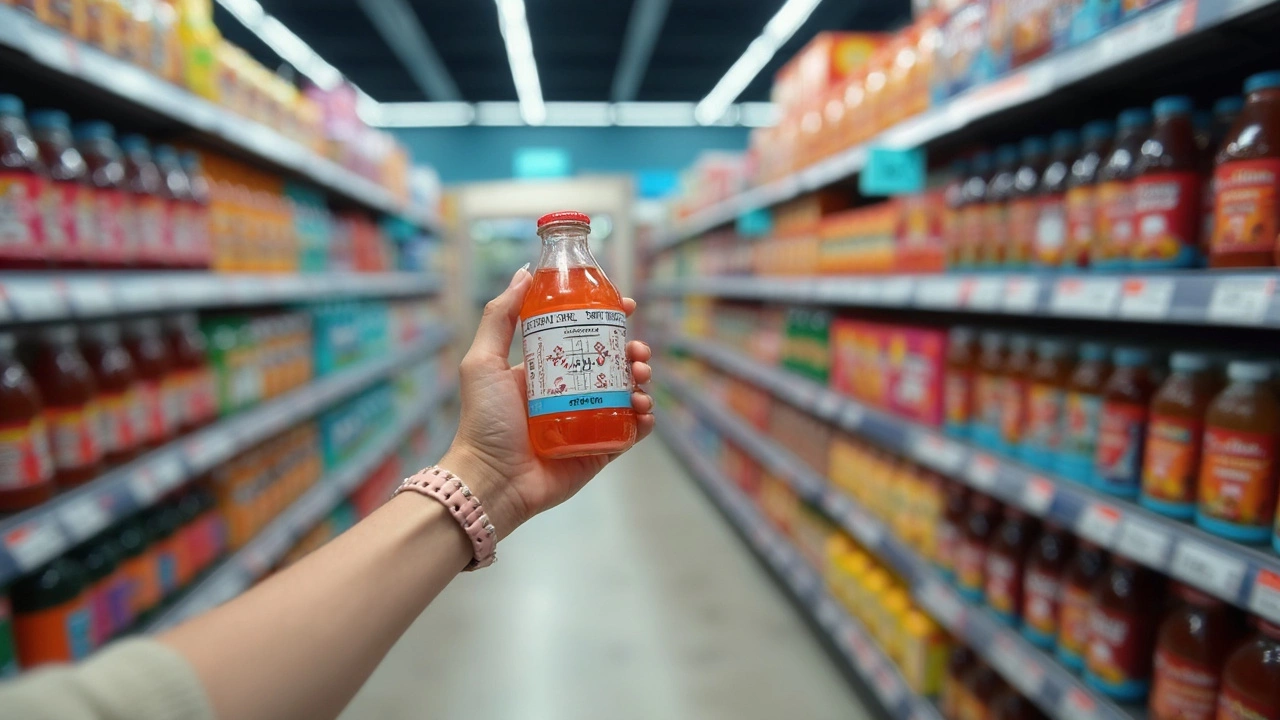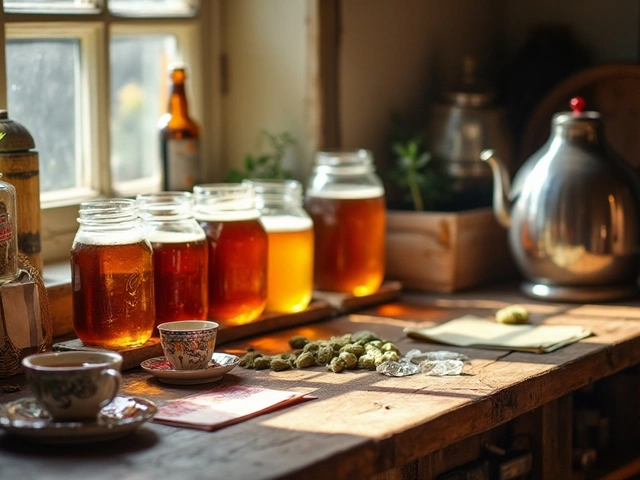You probably don’t think twice about grabbing a can of soda or fruit punch, but have you ever wondered which soft drink tops the list as the unhealthiest in the world? Spoiler: It’s not some weird chemical concoction—just your everyday super-sugary soda. That’s right, the stuff you find at every corner store is doing way more damage than you’d guess.
Why? It’s all about the sugar. Some of these drinks cram more sugar in a single bottle than you’ll find in a slice of chocolate cake. Most people don’t stop at one can either. My son Lennox once chugged a whole 20-ounce bottle at a party, and that one drink had almost 16 teaspoons of sugar. That’s double what health experts say kids should get all day, and it’s not doing adults any favors either.
If you’re picturing fruit juice as a safe bet, think again. A lot of ‘fruit drinks’ and ‘vitamin waters’ are loaded with processed sugar and empty calories too. Checking the label is pretty much the only way to know what you’re really drinking. So next time you’re thirsty, take a pause at the fridge or vending machine. That colorful bottle might actually be the worst choice in the lineup.
- The Big Offender: Sugary Soda
- More Than Just Sugar: Hidden Dangers
- Kids, Teens, and the Health Hit
- Ditch the Worst: Smarter Swaps
The Big Offender: Sugary Soda
When people argue about the unhealthiest drink out there, regular soda almost always wins. Behind the flashy cans and catchy ads, sodas like cola, lemon-lime, and orange are basically liquid sugar with bubbles. Most standard sodas have zero nutrition—no vitamins, no fiber, just empty calories that hit your body hard and fast.
The numbers don’t lie. A typical 12-ounce can of classic cola packs about 39 grams of sugar. That’s almost 10 teaspoons in a single serving. The American Heart Association says adults should aim for no more than 36 grams of added sugar per day for men, and 25 for women. So, that one can of soda? It’s blowing past those daily limits. Kids get hit even harder because their sugar guidelines are even lower.
| Drink (12oz Can) | Sugar (grams) | Calories |
|---|---|---|
| Coca-Cola Classic | 39 | 140 |
| Mountain Dew | 46 | 170 |
| Pepsi | 41 | 150 |
| Sprite | 38 | 140 |
It’s not just about sugar overload either. When you drink soda, blood sugar skyrockets and crashes just as fast, leaving you hungry and tired. This rollercoaster, especially if you drink soda daily, boosts your risk for things like type 2 diabetes, weight gain, and heart disease. Ever wondered about tooth decay? The acids and sugars in soda team up to break down tooth enamel even faster than you’d expect.
People often switch to diet sodas thinking they’re beating the system, but research still questions long-term safety—some studies point to changes in gut health and even increased cravings for sweet foods.
- If you cut back on sugary soda, your body (and your dentist) will thank you.
- Water, sparkling water, or unsweetened teas are better options when you’re thirsty.
- For parents: limit soda at home and model good drink choices yourself. Kids copy what they see, not what they’re told!
Bottom line: out of all the non-alcoholic drinks, regular soda is the main one to watch out for. It’s sugar in disguise, and the health downsides add up fast, especially if you make it part of your daily routine.
More Than Just Sugar: Hidden Dangers
So, we already know that sugary sodas are at the top of the unhealthiest drinks list. But it’s not just about sugar. These drinks have other sneaky ingredients that mess with your health in ways that most people don’t even realize.
First up: artificial sweeteners. Companies use them in “diet” or “zero-calorie” sodas to replace sugar. Sounds good, right? Not so fast. Studies show that these sweeteners might actually train your body to crave more sweets. Long term, some research even points to links between these additives and headaches, gut issues, and even weight gain.
Next is phosphoric acid, which is in most colas. Phosphoric acid can lower your bone density if you’re drinking sodas like water. That means weaker bones over time, which really worries me now that my daughter Evanna is growing fast.
And let’s not forget caffeine. Sure, it gives a quick boost. But a 12-ounce can of some sodas can have as much as 50mg of caffeine. That’s a lot for kids and even messes up sleep cycles for adults. Plus, caffeine mixed with all that sugar gets you hooked much faster than you’d think, making it tough to cut back.
Here’s a quick table that breaks down what’s often inside the unhealthiest sodas, per 12-ounce can:
| Ingredient | Common Value | Known Risk |
|---|---|---|
| Sugar | 39g | Obesity, diabetes |
| Artificial Sweeteners | Acesulfame K, Aspartame | Cravings, possible gut changes |
| Phosphoric Acid | 30-40mg | Lower bone density |
| Caffeine | 30-50mg | Sleep issues, increased heart rate |
When you stack all these ingredients together, you see why a sugary drink is more than a quick treat—it’s basically a one-way ticket to a pile of long-term health problems.
So, next time you or your kids reach for that colorful can, just remember it’s not just the sugar count you need to consider. The other stuff inside can be just as risky, and it adds up fast if these drinks are part of your daily routine.

Kids, Teens, and the Health Hit
If there’s one group that takes the biggest hit from sugary drinks, it’s kids and teenagers. The numbers are flat-out wild. In the U.S., about two-thirds of kids and teens drink at least one sugary drink every single day. Studies show that between ages 2 and 19, these drinks often make up the biggest source of added sugar in their whole diet.
The risks aren’t just about getting a sugar rush or crashing after school. Excess sugar makes it way harder for kids to keep a healthy weight. There’s a straight-up connection between sugary drinks and childhood obesity, which has more than tripled since the 1970s. It gets worse—these drinks mess with kids’ teeth, raise their chances of type 2 diabetes, and can even affect their mood and energy. My daughter Evanna once complained of a headache and feeling “weird” after a party, and we figured out she’d had four cups of punch. The stuff wasn’t even tangy—just straight-up liquid sugar.
| Age Group | Avg. Sugary Drink Intake per Day | % Exceeding Added Sugar Limit |
|---|---|---|
| 2-5 years | ~6 oz | 24% |
| 6-11 years | ~10 oz | 49% |
| 12-19 years | ~18 oz | 62% |
The worst part? Kids and teens often can’t burn off the extra calories, so the sugar just lingers. There’s also growing evidence that drinking lots of sweet stuff when you’re young sets you up for bigger problems later—heart disease, fatty liver, and high blood pressure.
- Swap out sodas and "fruit drinks" for water, plain milk, or homemade smoothies.
- Get kids reading nutrition labels, so they can spot brands sneaking sugar into “healthy” looking drinks.
- Put limits on juice boxes and energy drinks at parties and school events.
If you want to protect your family, keeping sugary drinks in check is a solid place to start.
Ditch the Worst: Smarter Swaps
If you’re freaked out by how much sugar is hiding in your favorite soft drinks, the good news is swapping them out is easier than you think. You’re not stuck with plain old water (though water is great and your body loves it!). There are simple, tasty options that don’t wreck your health.
Let’s talk numbers for a second. Most sugary sodas crank out around 39 grams of sugar per 12 ounces. That’s as much sugar as nine Oreo cookies. Even ‘healthy-looking’ drinks like sports drinks and flavored teas can sneak in 20-30 grams of sugar per bottle—kids and adults both blow past daily limits way too fast.
| Drink | Average Sugar (per 12 oz) | Calories |
|---|---|---|
| Regular Soda | 39g | 150 |
| Fruit Punch | 38g | 160 |
| Sports Drink | 21g | 80 |
| Sweetened Iced Tea | 33g | 120 |
| Water | 0g | 0 |
| Sparkling Water (Unsweetened) | 0g | 0 |
| Homemade Infused Water | 0g | 0 |
Now for the swaps that don’t taste like punishment:
- Sparkling water: My kids were hooked after we tried a few flavors. No sugar, no calories, plus the fun fizz you get with soda.
- Homemade infused water: Throw in orange slices, strawberries, or cucumber. You get real taste, some vitamins, and nothing fake.
- Unsweetened iced tea: Steep tea, chill it, add lemon or mint. You control how much (if any) sweetener goes in.
- Diluted real fruit juice: If you miss that kick of flavor, mix half juice with half water. It slashes sugar and still feels like a treat.
- Milk or non-dairy alternatives: For growing kids, plain milk adds nutrients and protein—nothing you’ll find in the sugar bombs.
It’s wild, but just swapping out one can of regular soda a day for water or seltzer adds up to saving 14,000 calories a year. That’s the equivalent of about four pounds of body weight, just from ditching one drink. The easiest way to avoid the unhealthiest drink? Keep healthy choices in the fridge, skip the soda aisle at the store, and encourage kids and adults to taste-test their way through these swaps until they find a favorite. Your body (and probably your dentist) will thank you.


